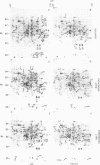Abstract
The effect of salt stress on polypeptide and mRNA levels in roots of two barley (Hordeum vulgare L.) cultivars differing in salt tolerance (cv CM 72, tolerant; cv Prato, sensitive) was analyzed using two-dimensional polyacrylamide gel electrophoresis. Preliminary experiments indicated that germination of Prato was inhibited significantly in the presence of NaCl, but growth of the surviving Prato seedlings was not substantially different from that of CM 72. Fluorographs of two-dimensional gels containing in vivo labeled polypeptides or in vitro translation products were computer analyzed to identify and quantitate changes that resulted when plants were grown in the presence of 200 millimolar NaCl for 6 days. The patterns of in vivo labeled polypeptides and in vitro products of CM 72 and Prato were qualitatively the same. Salt caused quantitative changes in numerous polypeptides and translatable mRNAs, but, overall, the changes were relatively small. Salt did not induce the synthesis of unique polypeptides or translatable mRNAs and did not cause any to disappear. Because of the similarities of the two cultivars with respect to growth and polypeptide patterns and the slight changes in polypeptide and translation product levels caused by salt, specific polypeptides or translatable mRNAs that are related to salt tolerance in barley could not be identified.
Full text
PDF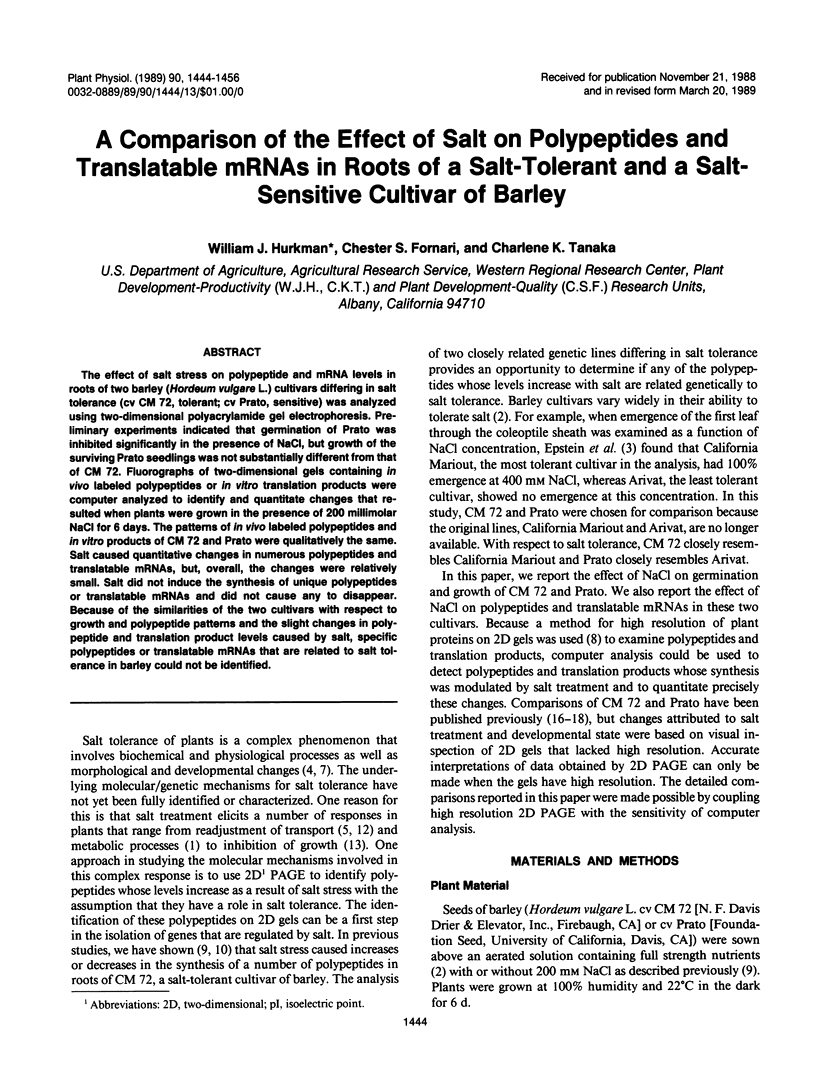
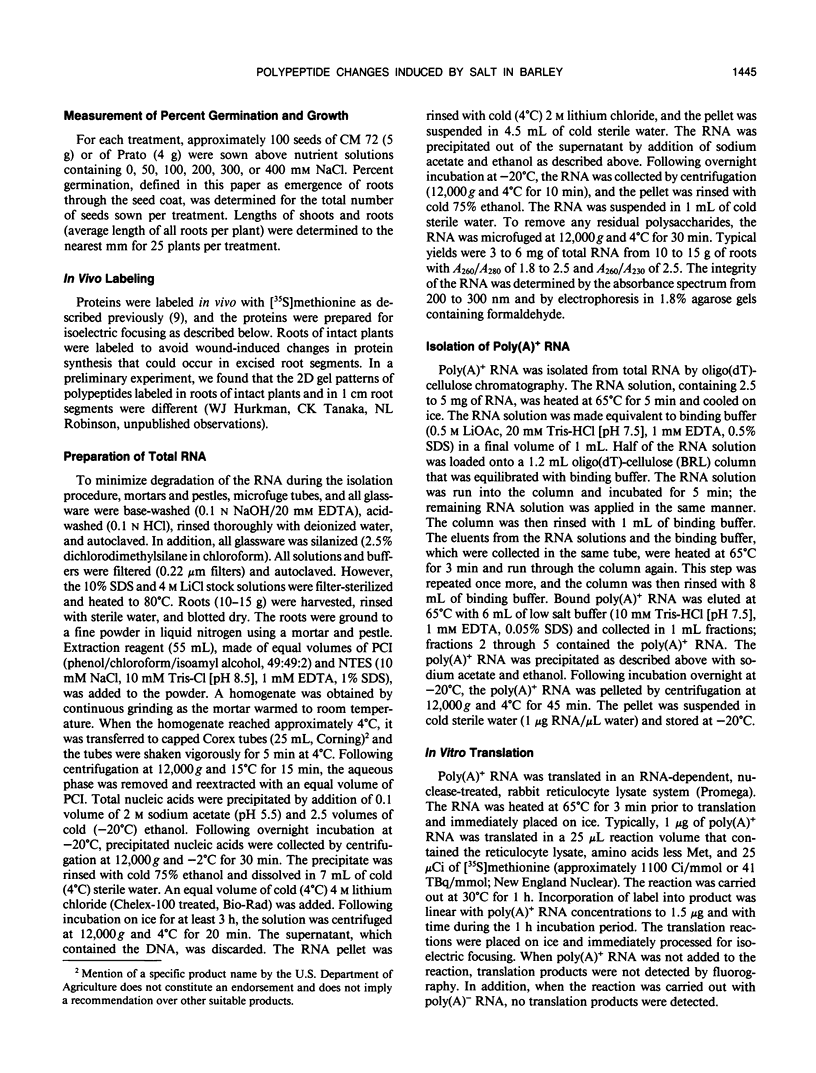
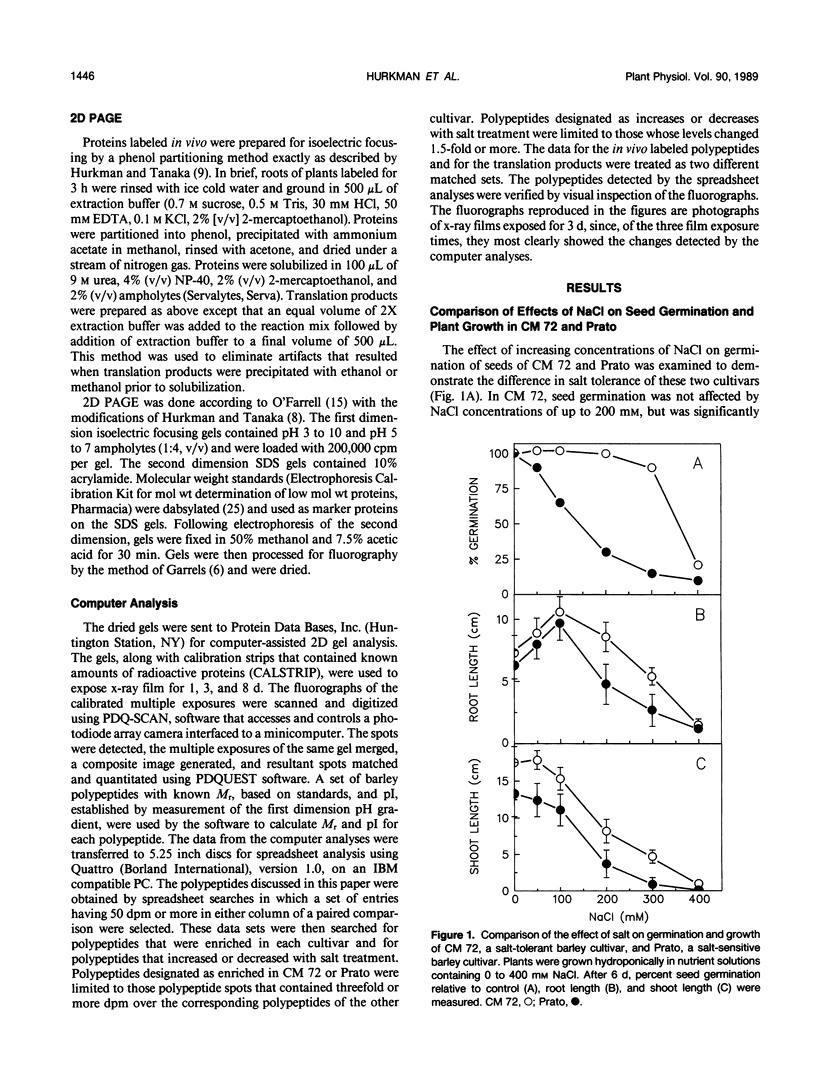
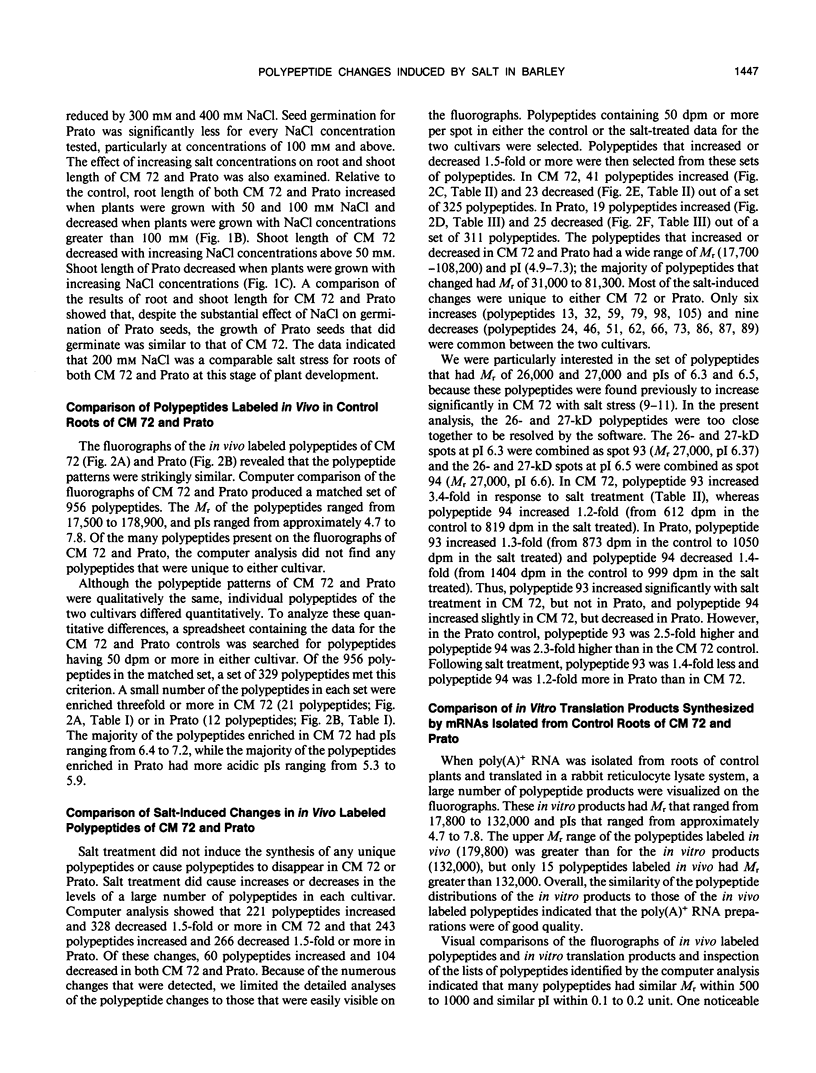
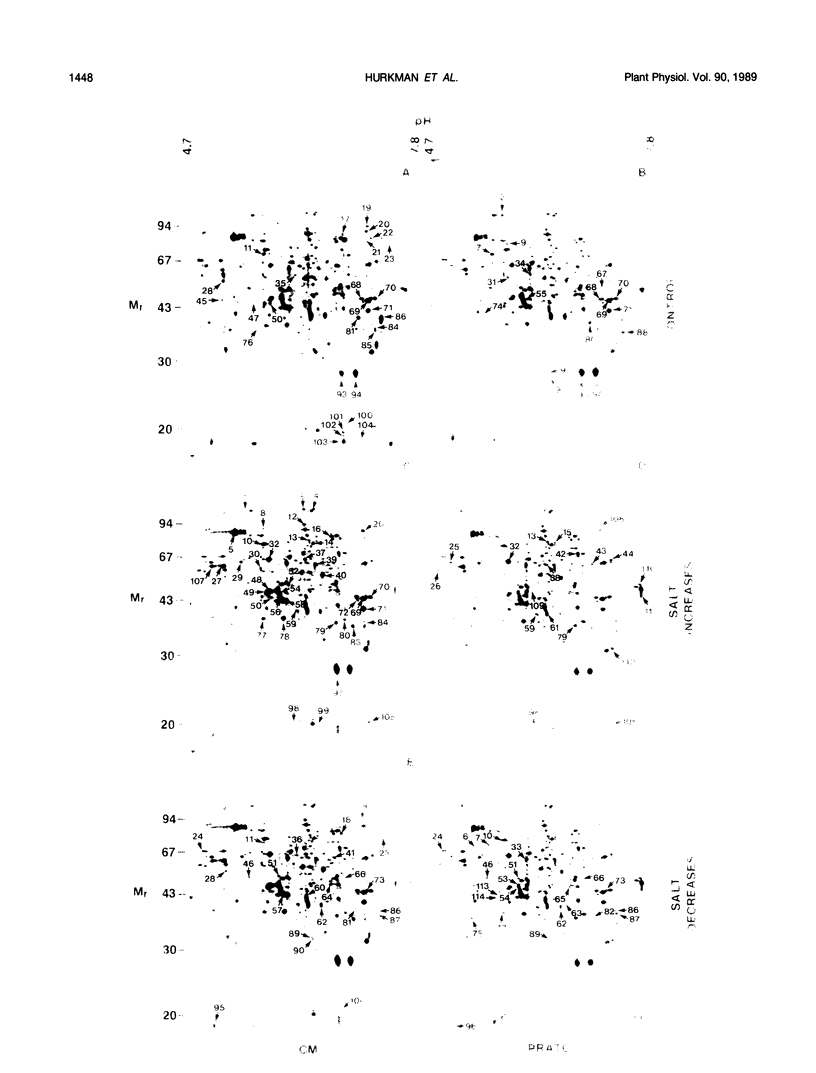

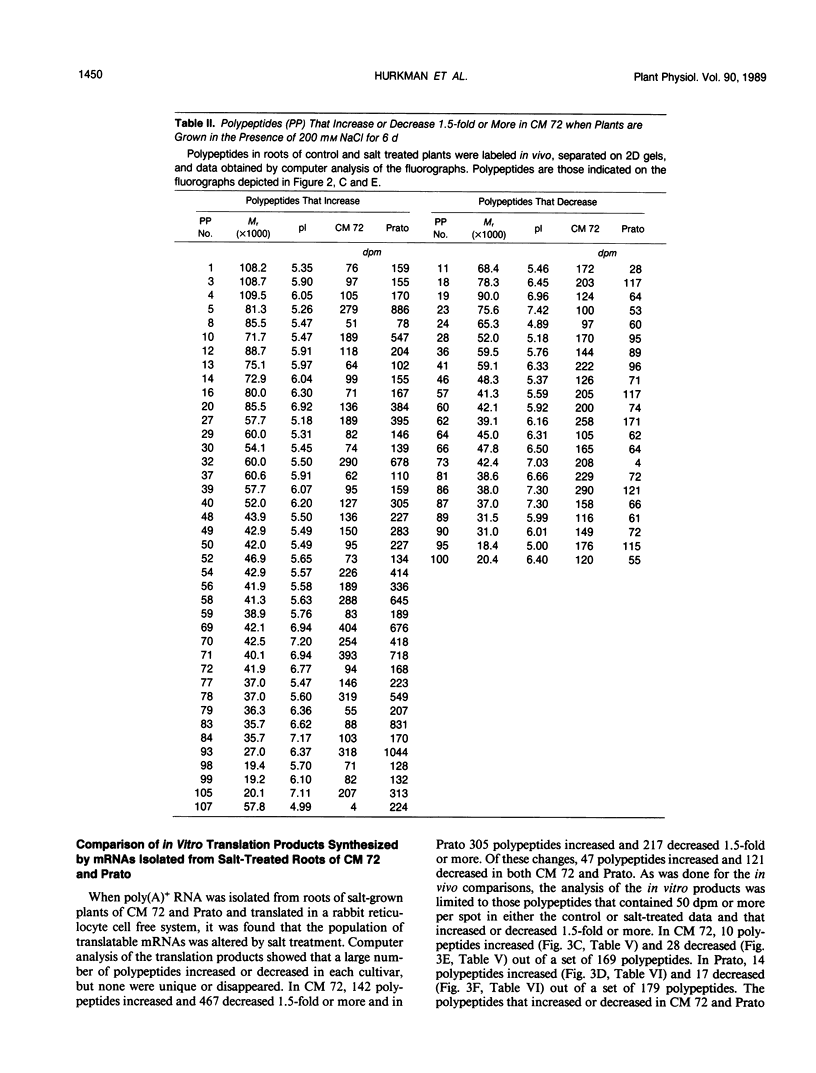
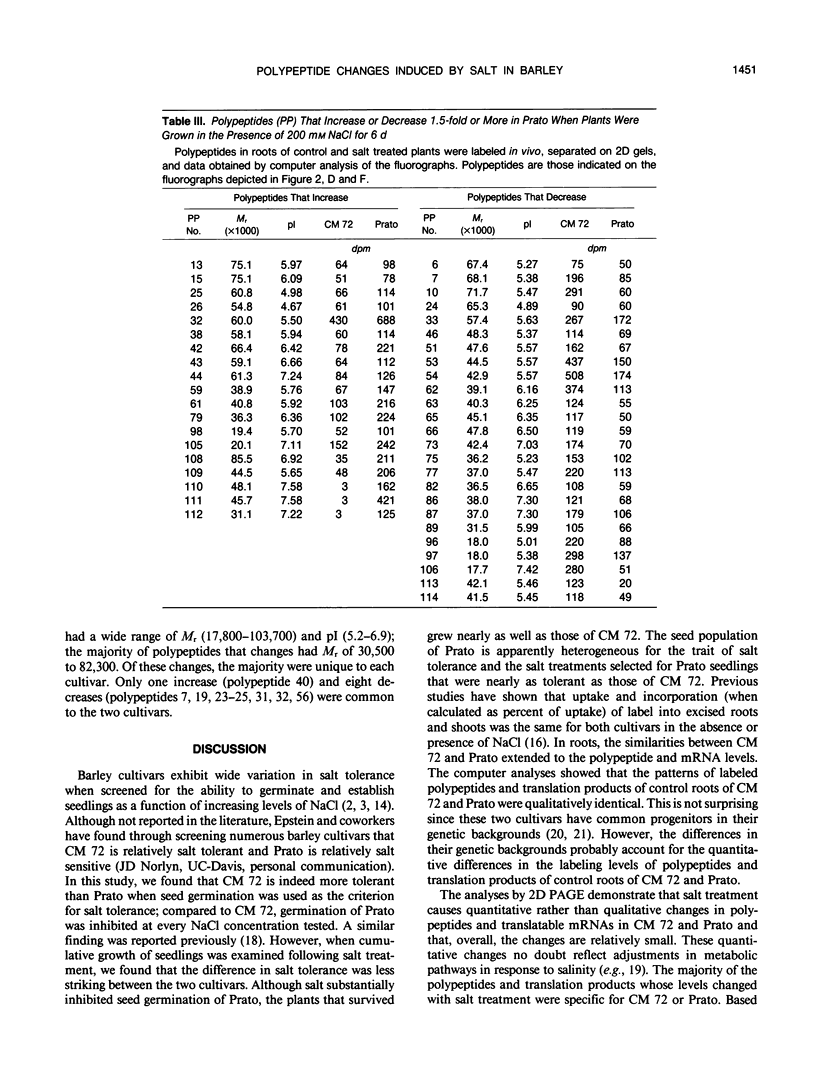
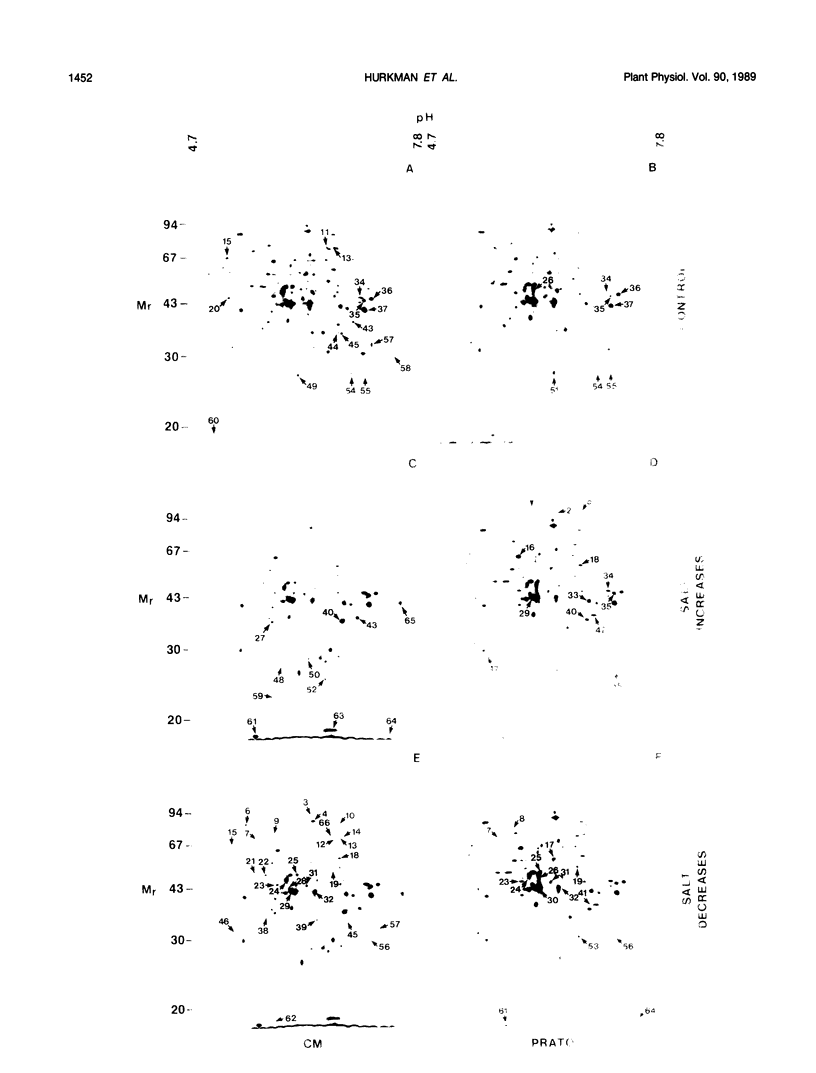
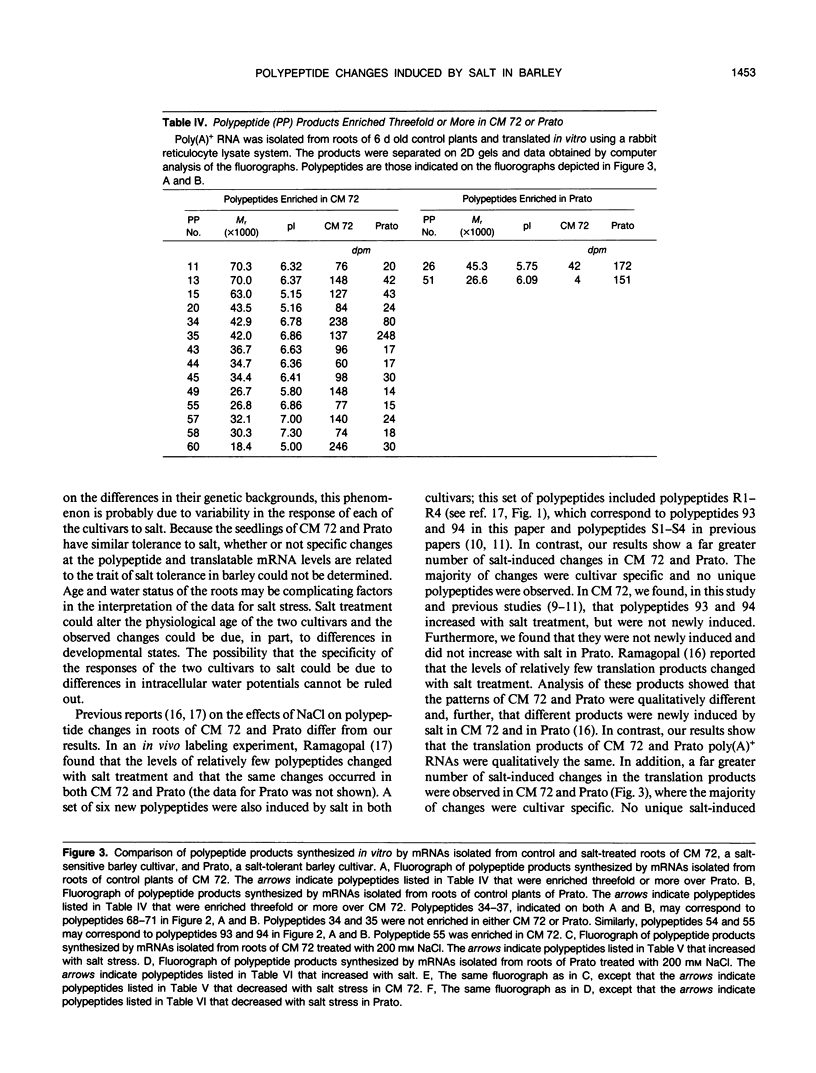
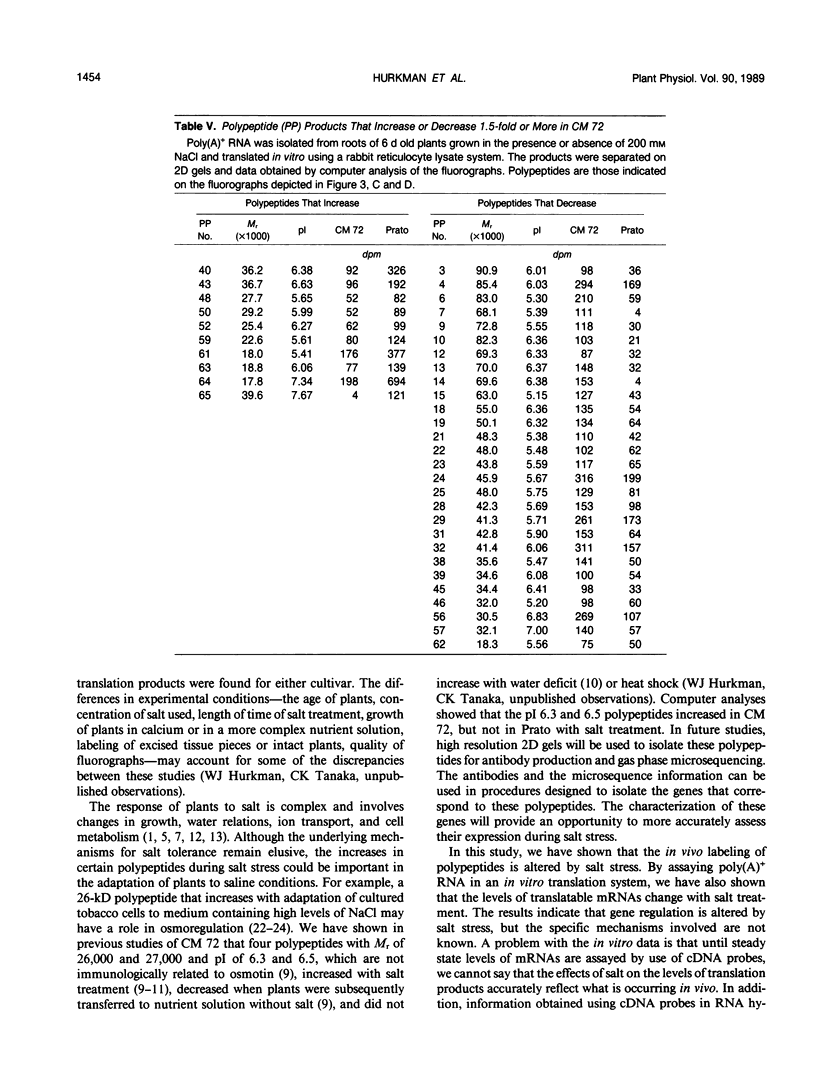
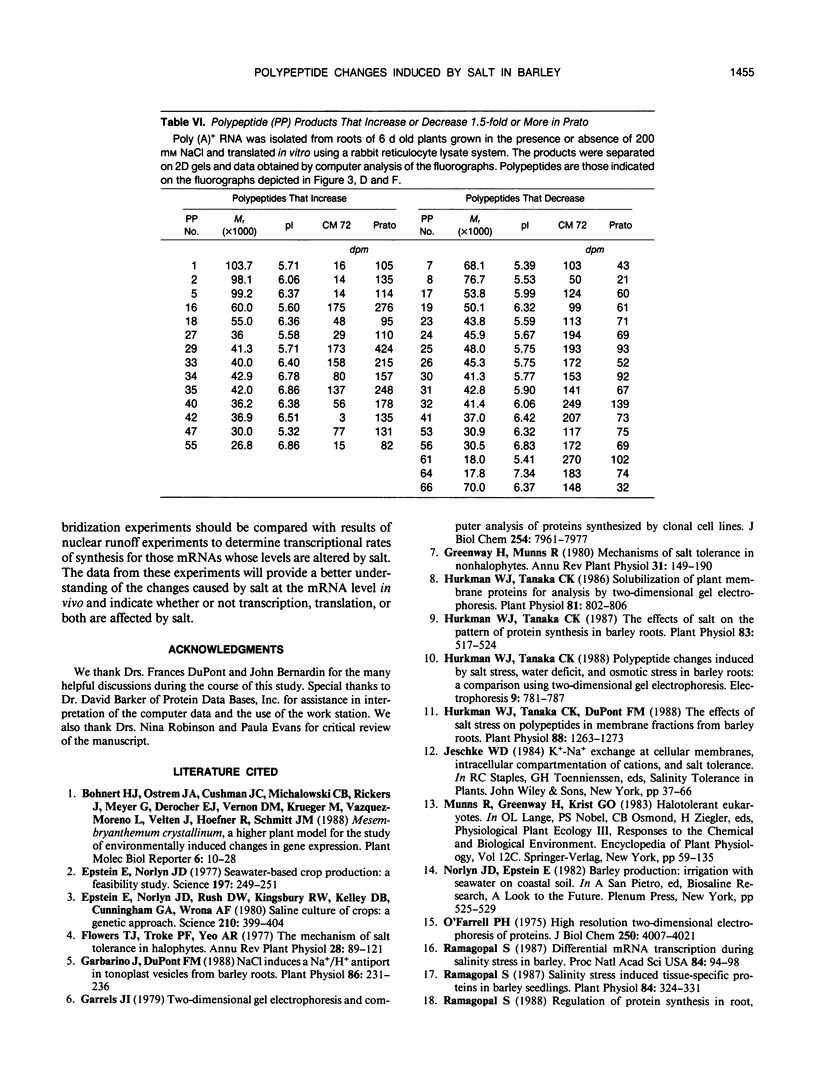
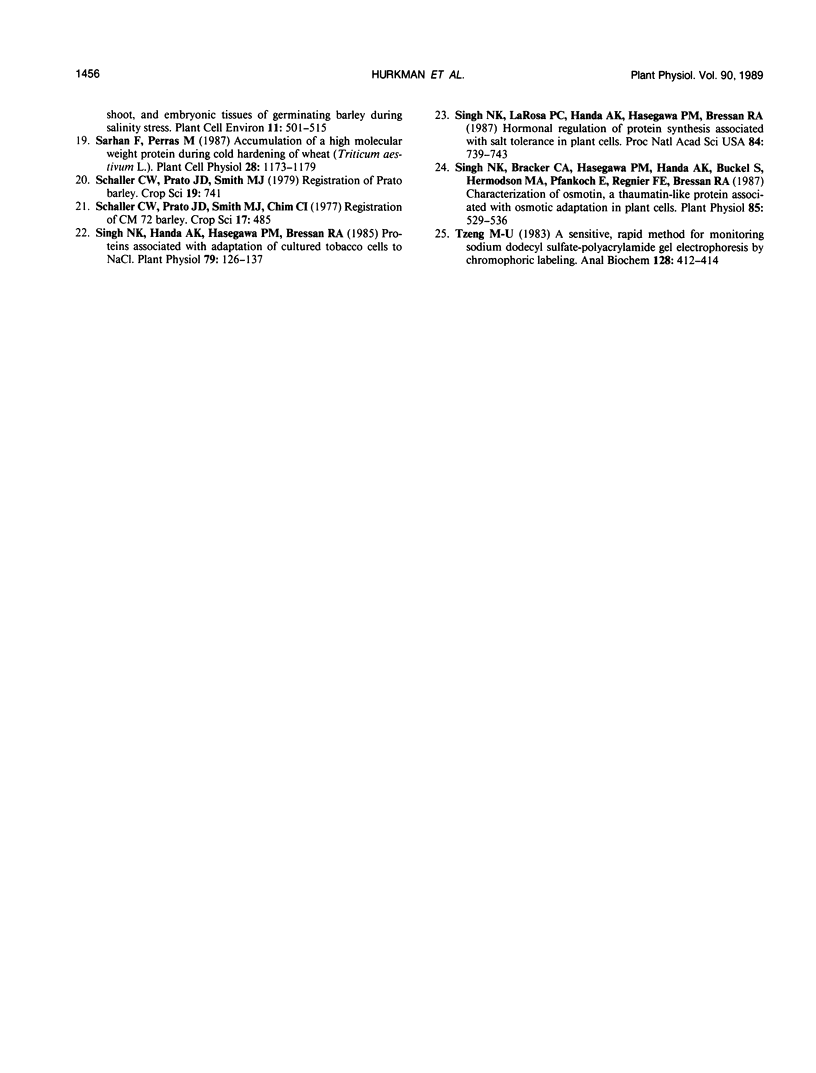
Images in this article
Selected References
These references are in PubMed. This may not be the complete list of references from this article.
- Epstein E., Norlyn J. D., Rush D. W., Kingsbury R. W., Kelley D. B., Cunningham G. A., Wrona A. F. Saline culture of crops: a genetic approach. Science. 1980 Oct 24;210(4468):399–404. doi: 10.1126/science.210.4468.399. [DOI] [PubMed] [Google Scholar]
- Epstein E., Norlyn J. D. Seawater-based crop production: a feasibility study. Science. 1977 Jul 15;197(4300):249–251. doi: 10.1126/science.197.4300.249. [DOI] [PubMed] [Google Scholar]
- Garbarino J., Dupont F. M. NaCl Induces a Na/H Antiport in Tonoplast Vesicles from Barley Roots. Plant Physiol. 1988 Jan;86(1):231–236. doi: 10.1104/pp.86.1.231. [DOI] [PMC free article] [PubMed] [Google Scholar]
- Garrels J. I. Two dimensional gel electrophoresis and computer analysis of proteins synthesized by clonal cell lines. J Biol Chem. 1979 Aug 25;254(16):7961–7977. [PubMed] [Google Scholar]
- Hurkman W. J., Tanaka C. K., Dupont F. M. The effects of salt stress on polypeptides in membrane fractions from barley roots. Plant Physiol. 1988 Dec;88(4):1263–1273. doi: 10.1104/pp.88.4.1263. [DOI] [PMC free article] [PubMed] [Google Scholar]
- Hurkman W. J., Tanaka C. K. Polypeptide changes induced by salt stress, water deficit, and osmotic stress in barley roots: a comparison using two-dimensional gel electrophoresis. Electrophoresis. 1988 Nov;9(11):781–787. doi: 10.1002/elps.1150091114. [DOI] [PubMed] [Google Scholar]
- Hurkman W. J., Tanaka C. K. Solubilization of plant membrane proteins for analysis by two-dimensional gel electrophoresis. Plant Physiol. 1986 Jul;81(3):802–806. doi: 10.1104/pp.81.3.802. [DOI] [PMC free article] [PubMed] [Google Scholar]
- Hurkman W. J., Tanaka C. K. The effects of salt on the pattern of protein synthesis in barley roots. Plant Physiol. 1987 Mar;83(3):517–524. doi: 10.1104/pp.83.3.517. [DOI] [PMC free article] [PubMed] [Google Scholar]
- O'Farrell P. H. High resolution two-dimensional electrophoresis of proteins. J Biol Chem. 1975 May 25;250(10):4007–4021. [PMC free article] [PubMed] [Google Scholar]
- Ramagopal S. Differential mRNA transcription during salinity stress in barley. Proc Natl Acad Sci U S A. 1987 Jan;84(1):94–98. doi: 10.1073/pnas.84.1.94. [DOI] [PMC free article] [PubMed] [Google Scholar]
- Ramagopal S. Salinity stress induced tissue-specific proteins in barley seedlings. Plant Physiol. 1987 Jun;84(2):324–331. doi: 10.1104/pp.84.2.324. [DOI] [PMC free article] [PubMed] [Google Scholar]
- Singh N. K., Bracker C. A., Hasegawa P. M., Handa A. K., Buckel S., Hermodson M. A., Pfankoch E., Regnier F. E., Bressan R. A. Characterization of osmotin : a thaumatin-like protein associated with osmotic adaptation in plant cells. Plant Physiol. 1987 Oct;85(2):529–536. doi: 10.1104/pp.85.2.529. [DOI] [PMC free article] [PubMed] [Google Scholar]
- Singh N. K., Handa A. K., Hasegawa P. M., Bressan R. A. Proteins Associated with Adaptation of Cultured Tobacco Cells to NaCl. Plant Physiol. 1985 Sep;79(1):126–137. doi: 10.1104/pp.79.1.126. [DOI] [PMC free article] [PubMed] [Google Scholar]
- Singh N. K., Larosa P. C., Handa A. K., Hasegawa P. M., Bressan R. A. Hormonal regulation of protein synthesis associated with salt tolerance in plant cells. Proc Natl Acad Sci U S A. 1987 Feb;84(3):739–743. doi: 10.1073/pnas.84.3.739. [DOI] [PMC free article] [PubMed] [Google Scholar]
- Tzeng M. C. A sensitive, rapid method for monitoring sodium dodecyl sulfate-polyacrylamide gel electrophoresis by chromophoric labeling. Anal Biochem. 1983 Feb 1;128(2):412–414. doi: 10.1016/0003-2697(83)90394-9. [DOI] [PubMed] [Google Scholar]



